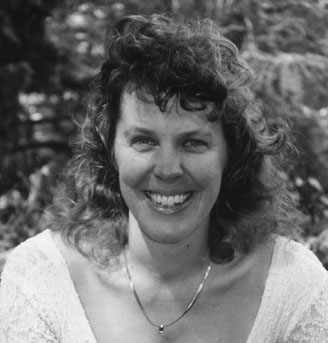
Introduction
Peter Russell's Keynote Address
Deborah Rozman on Heart Intelligence
Elisabeth Targ on Distant Healing
William Tiller on Animate/Inanimate Interactions
Paul Ka'ikena Pearsall on Wishing Well
A Steven Halpern Concert
This year’s International Conference on Science and
Consciousness (ICSC) was held at the Crowne Plaza Hotel in Albuquerque, New
Mexico. More than 800 people from 14 different countries attended. The ICSC
was divided into four concurrent sessions for most of each of the five
days, with everyone coming together for the keynote addresses and
presentations at the beginning and end of each day.
I arrived at the
Crowne Plaza Hotel the day before the conference began to meet a friend who
showed me some of the natural beauty of the wild areas around Albuquerque.
New Mexico is known as the "Land of Enchantment." The New Mexico
sky is so big and clear that you can spin around and around and still feel
like there's more sky than you could ever see. Plateaus of red rocks rise
up from the earth like ancient sentinels, watching all who come their way.
Fragrant grasses sway in the breezes that blow through, and clouds form
dramatically overhead – sometimes bringing rain.
Rain storms can
instantly transform this dry land to deep, sticky red mud. I can see the
signs of those recent rains in parched little mushrooms that rose up to
greet the sun, and still remain standing in place long after the moisture
from those rains has left.
When the conference
started on Saturday morning, I felt extremely fortunate to be there with so
many other wonderful people! There were more than 50 presenters in
attendance, as well as hundreds of attendees united with a shared passion
for exploring the connections between science and consciousness. This was
truly a magical event!
Peter Russell's Keynote Address:
Consciousness: Bridging Science & Spirit
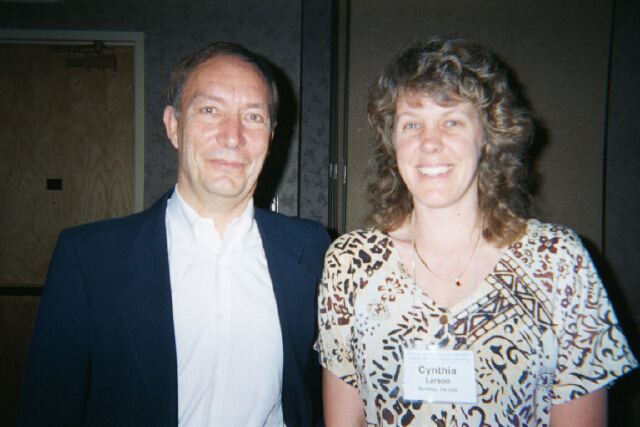
Peter Russell and Cynthia Sue
Larson
British author
Peter Russell, the first keynote speaker, started the conference with a
brilliant talk about science and consciousness. A student of Stephen
Hawking at the University of Cambridge, Russell is the author of The Brain
Book, The Global Brain Awakens, The Creative Manager, and Waking Up In
Time. As a respected scientist, scholar, visionary and futurist, Russell
explores the potentials of human consciousness, balancing knowledge of
Western science with his acquired Eastern wisdom. (See Peter's website at
http://www.peterussell.com/.)
Peter Russell's
charming English accent artfully conveyed his message that we are still
learning what consciousness is. Some scientists disagree that everything is
conscious ... or even that such a thing as consciousness exists! This
confusion arises because science only focuses on the known world, while
consciousness focuses on the knower. Russell summed this up by saying,
"When science opens up to looking at what consciousness is, it opens
up to a whole new understanding of spirituality and what God is all about
– because consciousness is the bridge from Science to God."
Russell told the
story of how he'd started out as a scientist with no interest in God. When
he was a young boy, he went to church as an Anglican, and had his
confirmation ceremony at the age of 13. By the time he had turned 15 years
old, Russell decided he was an atheist, although he quipped, "I later
realized I'm an atheist who believes in God!" When Peter studied the
wave equation for hydrogen in college, he marveled that we can deduce the
nature of the universe mathematically! But how could that be … how had
the universe become conscious of itself in such a way that we could
participate in witnessing the elegance of creation?
To find out,
Russell studied psychology – particularly the fields of memory and
perception – but was disappointed to discover that consciousness was
never mentioned. Russell found information about consciousness in Eastern
traditions, which help us free ourselves of our fears, judgments, belief
systems and everything else that blocks us from living fully enjoyable
lives.
As Russell
described it, consciousness is something that everything has, and that
space and time and matter arise from. "We all have the ability to have
experiences, and we are even self-conscious. If you think about how a film
projector works, where white light shines through some film and an image
results on the screen, you can see how we all have the same basic conscious
illumination, like that light source – the light is exactly the same
for each of us."
Russell continued,
"The simple fact that we are conscious presents a gigantic problem for
science. Many scientists would ignore consciousness altogether if they
could, but consciousness is undeniable. While scientists pride themselves
on predictability, there is nothing in science that predicts consciousness!
The hard problem of consciousness is, how the hell does it happen?!? The
easy problem is understanding the brain functions, although we are still a
long way from having a complete understanding of that. My view is that this
isn't actually a hard problem. It's actually an IMPOSSIBLE problem …
within the existing scientific paradigm. Behind every science is a belief
system, and those change with time. The Greek worldview changed with the
coming of Newton, and then Einstein's relativity changed the Newtonian
paradigm. As Niels Bohr once said, 'Scientists never change their mind.
What happens is that old scientists die.'"
Even when a
scientific model is totally wrong, Russell pointed out that it can take
generations before people recognize a new paradigm. Anomalies can help show
us when our worldview is not the best … we can see how some aspects we
are studying don't easily fit the old paradigms. We're going through a
paradigm shift with all of our sciences, since the paradigm behind the
paradigms is being called into question. This metaparadigm says that the
world of space/time/matter is the 'real' world, and when we fully
understand that, we will understand the nature of the universe.
Consciousness is
the anomaly – we are certain we are conscious, and yet we can't
explain what consciousness is. Right now, scientists are
"epicycling." They are wondering how they can explain
consciousness in terms of the old metaparadigm. Even though so many
theories are being developed, all of those theories assume that
space/time/matter is the "real" world and consciousness arises
out of that.
Russell explained
that "to accept anomaly and build new paradigms … we must accept
the fact that consciousness is primary. It is part of the essential nature
of the universe, and space/time/matter comes out of it." We need to
see how the world looks when consciousness is fundamental. It's much more
mind-boggling to consider that everything we experience and know is
something happening inside consciousness! The brain recreates the
experience of the world in a tenth of a second, so we're always 1/10 of a
second behind, and the brain gets rid of this delay so we don't even notice
it. No one ever experiences the world directly – what we experience is
this wonderful virtual reality. Mystics know this.
Russell then
described the two fundamental laws of consciousness:
(1) Consciousness
is Creative – it can take on every single thought as we are creating
the whole world … everything we know is a creation of consciousness.
The question to ask is, "How does consciousness manifest for each of
us as space, time, and matter?"
(2) Consciousness
has Intention – Consciousness is intelligent! We all wish to feel
good; none of us wants to suffer or feel pain. As the Dalai Lama says,
"In the final analysis, the hope of every single person is peace of
mind." This is why we do everything … because we want to avoid
pain and suffering, and feel OK. Humans get caught up in all these beliefs
of what will make us feel good, so we worry about not having enough. We get
sucked into the delusion that we are experiencing the external world
directly.
Russell examined
how this delusion that we are experiencing the external world affects our
sense of inner peace and happiness. "Our belief system has a great
deal to do with our happiness. The idea that if we only got enough things,
we'd finally be at peace is rubbish! Happiness depends on our perceptions.
Buddha's four noble insights showed us how whether or not we suffer is our
own creation, and we can undo that. We create our experience of the world.
If we don't like it, we can change it."
"We often
identify with our body, and this is a delusion! Everything is a creation in
consciousness. YOU are consciousness, none other than the pure faculty of
consciousness. When we ask, 'Who am I?', the 'I' is consciousness itself.
Thomas Merton said, 'If I penetrate to the depth of my own existence, to
the indefinable … then I pass into the indefinable I AM.' The real
nature of consciousness is divine, which doesn't always go down so well!
When we delve down to the deepest essence (still mind) and arrive at pure
faculty of consciousness … that IS divine experience! God is truth,
consciousness is truth (the one thing we cannot deny). God is in All, and
consciousness is in All. When we look into another person's eyes or just
listen to them, we experience another light of consciousness … the
divinity of inner light in another. God is Love, and the real nature of
consciousness is Loving. When we treat other people as objects, it
separates us. When we see that behind those experiences is the same light
of consciousness, we feel connected."
Peter Russell
closed his keynote address by asking us the following question for further
contemplation: "Consider this hypothesis for scientific examination in
our lives: Consciousness is Universal, Primary, and Divine! If each of us
is divine, how then will we live and relate to other people?"
Heart Intelligence: The Science of Individual,
Social & Global
Coherence
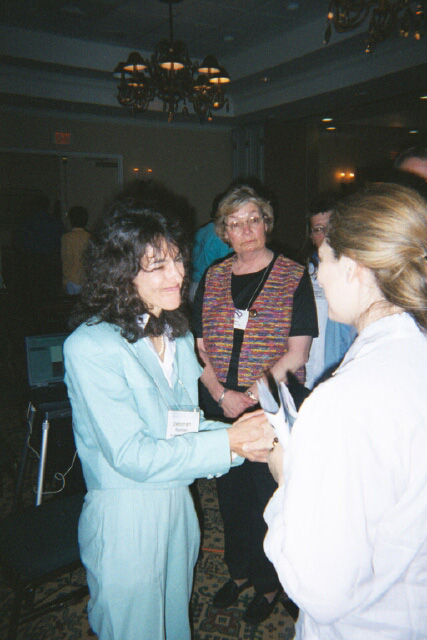
Deborah Rozman
After Peter Russell's keynote address, I had to choose between
four excellent concurrent sessions! I selected Deborah Rozman's HeartMath
workshop, since I know that HeartMath's work relates closely to what I am
doing … they demonstrate and teach the significance of "thinking
with the heart" to improve people's health and intuitive
abilities.
Deborah Rozman, a
psychologist, is the Executive Vice President of HeartMath, the author of
five books, and the editor of many others. Rozman currently conducts
workshops and trains trainers in HeartMath's programs focusing on heart
intelligence as it applies to intuitional development, women's issues,
parenting, personal effectiveness, and empowerment.
Rozman began her
workshop by describing how coherence occurs as we feel loving and loved. In
the field of physics, coherence is defined as a single waveform that does
not vary over time, or the synchronization that occurs between two or more
waveforms. In psychology, coherence is defined as the quality of being
logically integrated. Rozman explained that coherence occurs within our
bodies when the variable distance in time between our heart beats
stabilizes. This state of psychophysical coherence is characterized by
mental and emotional stability, with feelings of greater synchronization
and harmony.
Rozman showed a
diagram of a circular cycle that showed how our perceptions are influenced
by neural circuits, and how these perceptions then influence our thoughts
and emotions. Our thoughts and emotions subsequently create physiological
effects in our bodies, which then affect the neural circuits. This loop
illustrates how we can get stuck in mindsets or preset patterns in which we
habitually respond in similar ways. These patterned responses are the
"stuff" that we have to deal with within ourselves and
society.
These patterns
wouldn't matter so much if so many of us weren't feeling intense levels of
stress in our lives. Proctor & Gamble's Roper global consumer 2000
study recently indicated that a large percentage of the American populace
say they feel "super-stressed" (1 in 5 women, and 1 in 7 men). We
need to find new ways to cope with all this stress. Rozman asked us to
ponder the following statement: "The mind is to the brain as intuition
is to the heart." She added, "Emotion is energy in motion –
we can find movement in our emotions, and choose to access the direct
intuitive knowingness of our hearts."
Rozman showed a
photograph of her son and his dog – with a chart alongside the photo
showing the distance between their heart beats, and how they became
coherent (or stabilized) during the time the dog and her son were loving
each other! It was so sweet to see love's great healing effects in this
picture. Rozman said, "Coherence (love) is a scientifically proven,
universal guiding principle for behavior. Anger is like an emotional virus;
one or two angry people can take pent-up anger and stress and infect a
whole room."
Considering the
contagious quality of emotions, it's good to remember that appreciation and
love have much more power than other less coherent emotions, and also that
our heartbeats affect the brainwaves of others! Rozman continued to explain
that, "Heart intelligence gives us the ability to have the 'Aha!' When
you put your heart into something, you get more coherence. When we apply
the insight that we can learn to get out of feeling of whatever stressful
emotion for a moment, going to neutral without 'stuffing' the emotion, we
can feel some appreciation and compassion and get to a higher
perspective."
Our hearts have so
many neural connections that they can be considered a "brain" in
their own right. That 'brain' inside the heart keeps hearts pumping even as
they are being surgically transplanted from one person's body to another.
Our hearts are also the one thing in our body that can neutralize the fears
and stresses that our brains get us into! When people learn how to bring
their heartbeats into a state of coherence where variations between
heartbeats are smoothed out by practicing feeling love and appreciation,
they are literally creating new neural pathways. The heart is a
neurological organ, as well as the source of our pulse. It is the source of
many important hormones, and the generator of a large electrical field
(which has been measured extending ten feet or more beyond the body).
The heart also contains memory cells. Sometimes, people who have
undergone heart transplant surgery notice that they receive the memories of
their heart's donor. This side-effect of heart transplant operations leaves
heart recipients with new memories that feel just as real as memories from
their own life experiences. These new memories fade after a little while,
being strongest immediately following the transplant surgery. It takes some
time for the heart cells to receive the memories and experiences of the
heart recipient.
Rozman explained
that we can intentionally change the way the cells in our bodies respond to
stress by entraining ourselves. When we (1) shift our awareness to our
heart; (2) activate the emotional feelings of love, compassion and
appreciation; and (3) ask our hearts what to do – we are entraining
three things. We are entraining our respiration, our pulse rate, and our
heart rhythm. This affects the rest of our body, and it also affects
everything and everyone around us.
Since feelings of
anger, hurt, and frustration are all based on perception, we can change our
habitual reactions to stress by learning to focus on love and appreciation,
especially in times of stress. The cells in the amygdala that store old
memories (and overrides what we know we should do) then synchronize with
the pacemaker cells of our heart, and reprogramming our habitual stress
reactions can happen very quickly. They can happen quickly precisely
because the amplitude of coherence (love) is so much more powerful.
Deborah Rozman gave
an initial demonstration of a biofeedback device that helps people
"entrain" their hearts – it's a Velcro strap to wrap around
your finger so that the fingertip presses onto a contact and the heartbeats
and time distance between heartbeats can be measured. Rozman gave us a
practice exercise of feeling love, compassion, and appreciation to get us
into "The Zone" … that place that athletes excel in and the
"intended state" of consciousness where we can live free of
stress and fear. Rozman demonstrated computer software that can be used in
conjunction with the biofeedback device, so that as you get into "The
Zone," a black and white picture begins to change into color, with a
flowing stream, flowers, and forest animals!
Many corporations
and schools are taking HeartMath classes to help employees and students be
more productive and healthier as they learn how to get and stay in
"The Zone." Even children have benefited from HeartMath's
training, and there are special classes available for kids.
Research in Prayer & Distance Healing:
Evidence &
Implications
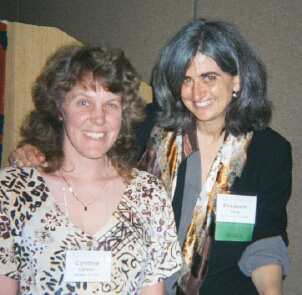
Cynthia Sue Larson and Elisabeth
Targ
The next session I attended was Elisabeth Targ's. Targ is the
acting director of the Complementary Medicine Research Institute at the
California Pacific Medical Center in San Francisco, where physicians are
trained in alternative medicine in addition to their traditional medical
training. Targ is also the Assistant Clinical Professor of Psychiatry and a
Fellow of the Institute of Noetic Sciences. Elisabeth Targ co-authored a
ground-breaking paper in the December 1998 Western Journal of Medicine,
titled "A Randomized Double-Blind Study of the Effect of Distant
Healing in a Population with Advanced AIDS," and she presented the
findings from this research along with that of several other significant
studies that indicate the power of prayer in healing. Elisabeth Targ
defines distant healing as "a conscious and compassionate act of
intervention intended to benefit the physical and/or emotional well-being
of another person at a distance."
Elisabeth Targ
started her talk by discussing the differences between people who use
conventional medicine and those who use alternative medicine. Alternative
medicine users also utilize conventional medicine, and feel it is important
to work with the mind, body, and spirit as part of their care. The
alternative medicine recipients also are more likely to have had
transformative experiences … as Targ put it, "These are NOT the
angry types!"
"Scientific
data is an important form of communication," Targ said, and she is
pleased to see that the field of medicine appears to be the first place
where consciousness researchers are able to make inroads towards
scientifically demonstrating verifiable evidence of non-local physical
affects from consciousness.
Targ's initial
interest in studying the effectiveness of distant healing was to determine,
if prayer worked, who did it work for? Was it something that only worked
for those who had the hopes and expectations for prayer to work, or is
distant healing something that works regardless of the recipient's desire
for it to work?
While many research
studies have been conducted to answer these questions, most prayer studies
are not yet found in scientific journals. There has been some difficulty
conducting research in this area, precisely because some of the labels used
to find the elusive mechanism behind distant healing such as "Extra
Sensory Perception" (ESP), or intrinsic meaning have sometimes been
cited as evidence of psychopathology. Serious scientific researchers are
therefore understandably cautious and a bit uncomfortable about publicly
announcing their studies in this field, since they wish to avoid being
labeled "crazy."
Much scientific
research has been conducted in a veil of secrecy. For example, Elisabeth
Targ mentioned how a recent three day conference at Harvard University on
the subject of Prayer and Distant Healing was conducted on a confidential,
invitation-only basis so the public would not know about it! Such secrecy
in the field of distant healing gives the public a false illusion that not
much scientific research is being done, when this is far from the
truth.
Targ was quite
pleased to tell us that the National Institute of Health (NIH) now funds
research and awards grants for a new category called, "Distant Mental
Influence on Biological Organisms"! This broad umbrella covers a wide
range of topics, such as: psychic healing, therapeutic touch, non-local
healing, subtle energy healing, prayer, intentionality healing,
laying-on-of-hands, and spiritual healing.
Of the more than
135 distant mental influence on biological organisms studies, about
two-thirds have reported statistically significant results. One
particularly fascinating study in which healers strove to reduce tumors in
mice showed that the healers who were farthest from the mice had the
greatest success in shrinking those tumors!
Targ showed a slide
indicating how many of some of these studies had been conducted, and how
many had significant results. The first number was the number of
significant studies, and the second number was the total number of human
studies in that area:
• biofeedback (5/8)
•
hemoglobin increase (4/4)
• skin
wound healing (1/1)
•
hypertension (2/3)
•
asthma (0/1)
• CCU
recovery (1/1)
•
myopia (0/1)
•
tension headaches (1/1)
•
post-operation pain (1/2)
•
anxiety (6/8)
•
personal relationships (0/1)
•
depression (0/1)
•
self-esteem (1/1)
• AIDS
(1/1)
Targ described William Brouch's article in the Journal of
Transpersonal Psychology, "Distant Mental Influence of Rate of
Hemolysis of Human Red Blood Cells", and the amazing findings in which
nine of the thirty-two student subjects showed significant results when
non-locally "protecting" their blood samples which had been
placed in test tubes mixed with water.
Targ also briefly
described Randolph Byrd's "Positive Therapeutic Effects of
Intercessory Prayer in a Coronary Care Unit Population," published in
the 1988 issue of the Southern Medical Journal. Byrd's study analyzed 393
Cardiac Care Unit (CCU) patients at the San Francisco General hospital.
Christian prayer circles prayed for patients, and the prayed-for patients
experienced fewer complications (such as intubations, need for antibiotics
and diuretics, cardiopulmonary arrests, and pneumonia). While there was no
experimental control limiting "extraneous prayer" from those
prayer givers not officially chosen by Byrd and his team, the Byrd study
assumed that extraneous prayer should balance out and equalize between the
control and prayed-for groups. This and other studies have raised the
question about whether people should be prayed for without their
permission.
William Harris and
his team of researchers published their findings from attempting to
replicate Randolph Byrd's study in the October 1999 issue of Archives of
Internal Medicine as "A Randomized, Controlled Trial of the Effects of
Remote, Intercessory Prayer on Outcomes in Patients Admitted to the
Coronary Care Unit." Harris and his team succeeded in replicating
Byrd's study, and discovered that prayed-for patients fared better than the
control group, yet stayed in the hospital for about the same length of
time. Those doing the praying in the Harris study were required to agree
with the statement, "I believe in God. I believe that He is personal
and is concerned with individual lives. I further believe that He is
responsive to prayers for healing made on behalf of the sick."
Targ's 1998
double-blind study on AIDS patients used forty experienced distant healers
to pray for advanced-case AIDS patients. The healers were simply given
instructions to "hold an intention for the health and well-being of
the patient." Pair matching was done to control as much as possible
for variation in outcomes that might be related to major disease
progression and survival predictors, as indicated by the earlier pilot
study. Healers were required to have a minimum of five years distant
healing (DH) experience with at least ten patients, including AIDS
patients. The healers selected had an average of 17 years experience and
had previously treated an average of 106 patients at a distance.
The healers were
given a photograph, and the first name of the person to be prayed for
during that particular week. Each healer received a new patient to pray for
every other week. Prayers continued for one hour a day, over a period of
ten weeks. Thus, each subject receiving distant healing was treated by a
total of ten different practitioners, while each practitioner worked every
other week treating a total of five subjects.
Each of the
different healers used different techniques (such as Christian, Jewish,
Buddhist, Native American, shamanic, bioenergetic and meditative),
according to what worked best for them. DH Practitioners were not paid and
understood that the study could not evaluate the abilities of any
particular healer. Healers would often see or feel the energy in those they
were praying for; some would beat drums, some would get visions, and some
would send in energy with sound and light or work with spirits.
At the end of the
ten week study period, the AIDS patients in the Distant Healing group were
found to require less medical care, have fewer and less severe new
illnesses, and their moods improved. This outcome is surprising, because
this was a double-blind study in which subjects, physicians, and study
personnel did not know who was in the treatment group. There are two
explanations other than DH effect that might also cause these differences:
baseline medical or treatment differences, and expectation or the placebo
effect.
We can rule out the
baseline medical or treatment differences, since there were no
statistically significant differences between the DH and control groups.
The expectation or placebo effect can be ruled out, because the only
outcome measure showing correlation with subject belief that they were
being prayed for (whether or not that turned out to be the case) was the
CD4 count, and interestingly, this correlation only held up at study
midpoint, and not the end of the study.
Existing medical
understanding offers no mechanism yet for why distant healing should be so
effective. Dr. Larry Dossey has pointed out that for years, nobody knew how
or why colchicine, morphine, aspirin, or quinine worked – yet they
were known to be effective, and so they were utilized. Possible mechanisms
for DH might include telepathic mind-to-mind communication between patient
and healer, or some form of energy transfer. These are areas for future
research. Targ and her team intend to repeat this experiment utilizing
nurses as the distant healers.
Exploring Robust Interactions Between Intention
&
Inanimate/Animate Systems: Theory
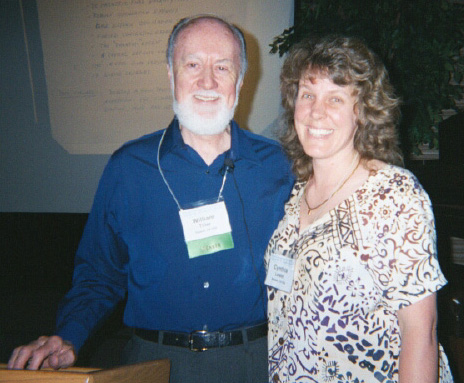
William Tiller and Cynthia Sue
Larson
William Tiller is a teacher, researcher, author and consultant,
and is currently Professor Emeritus of the Department of Materials Science
and Engineering at Stanford University. Formerly, he was an advisory
physicist at Westinghouse Research Laboratories. He has published 275
scientific papers and three technical books in the field of materials
science. Tiller has explored the area of spiritual development and the
physics of psycho-energetic phenomena, which has inspired him to write an
additional 80 scientific papers as well as his book Science and Human
Transformation: Subtle Energies, Intentionality, and Consciousness. Tiller
is a founding director of both The Academy of Parapsychology and Medicine,
and The Institute of Noetic Sciences.
William Tiller
presented the theoretical side of his work after explaining the experiments
involving robust interactions between intention and inanimate/animate
systems. Tiller reminded us of the "bodysuit metaphor," in which
we are all spirits having a physical experience as we go down the river of
life. We are intended to become co-creators with our spiritual creators,
and we can think of ourselves as having many layers … from the
electric monopole layer of physical reality to the magnetic monopole,
emotion domain, and mind domains. The spirit inside of us drives us, and
living is a process of building an infrastructure which allows more spirit
to enter dense matter.
Tiller explained,
"Spirit drives this biobodysuit vehicle! After all, 99.999% of all
physical 'matter' consists of vacuum, with BIG spaces between electrons and
nucleus. The energy potential, or latent energy, stored in one single
Hydrogen atom is equivalent to one trillion times all the energy in our
universe! If our consciousness could interact with the vacuum, we could
have some very BIG effects. We'll be able to use the physics of the vacuum
to get to the stars."
Tiller described
the importance of Dirac's work when he wanted to know where electrons came
from in the 1920's, and found that when an electron popped out of its atom,
it left a "hole" or positron behind. Antimatter are
"defects" in the sense that the holes in the substratum are
calculated to contain huge energy density, in a very chaotic structure with
lots of interference going on. Tiller was excited to point out that
"if we can do this for electron particles, we can do it for atoms and
molecules!" The vacuum is critically important to us, and De Broglie's
proposal that every particle had a "pilot" that guided it lead us
to contemplate the "deltron" particle.
Tiller described
the deltron as "an emotional particle that serves as a coupling
ingredient for faster than light and slower than light velocities,"
and gave the equation c squared = (velocity of particle) * (velocity of
pilot wave) with an illustration that showed four quadrants with velocity
expressed on the x-axis and energy on the y-axis. The upper left-hand
quadrant is the Physical branch, the lower right-hand quadrant is the
Etheric branch, the upper right hand quadrant is the electric superluminal
(tachyon) branch, and the lower left hand quadrant is the magnetic
subliminal branch (imaginary particles).
Tiller discussed
the nodal network model which works like transponders with hexagonal
close-packed (HCP) symmetry, and pointed out that "We need to practice
other cognitive domains ... we need to learn how to play with reciprocal
space blocks." He continued to say that "Reciprocal space
patterns create our immediate future! Everything is already
there."
All of these
theories will be published in Tiller's forthcoming book, due for release at
the end of the year 2000.
Following
Saturday's presentations by Huston Smith, Charles Tart, Jeffrey Mishlove,
Stanley Krippner, Amit Goswami, and Russell Targ (which I was unable to
attend because they overlapped with the sessions I just described above),
there was an evening keynote presentation by Paul Ka'ikena Pearsall and a
concert with Steven Halpern.
Wishing Well: Conscious Acts of Creation
Paul Ka'ikena
Pearsall is a clinical neuropsychologist and former professor of psychiatry
and behavioral neuroscience. He's written 11 books including Wishing
Well: Making Your Every Wish Come True, and The Heart's Code.
Pearsall discussed
"conscious acts of creation," also known as wishes! Pearsall
first asked the audience to write down in 8 words or less the one wish that
is most fundamentally important in life. He then involved the audience in a
wonderful exercise in which we learned the art of hula as prayer. We feel
transformed when we stand up, smile, and move our hands and feet to the
music. Pearsall is right – it feels great to experience music
physically, and to remember to smile and "go with the flow"!
Pearsall explained
how "the soul attracts what it secretly harbors," and asked us to
remember to focus our intent when we first wake up each morning. Those
first thoughts we think set the stage for the rest of our day, and someone
whose first thought is, "Another day in hell" will probably have
a very different experience from the person who wakes up wondering,
"What new adventures will I have today?" Pearsall asked us to
consider what the person who knows us best would say if asked whether we
were a pure pleasure to live with. Our words can heal, and our words can
destroy – yet often we don't note what we are saying to those we live
closest to.
Hawaiians believe
that our ancestors are with us now, and that by saying, "I wish to be
connected with everyone and everything with love," entirely different
realities emerge.
Pearsall reminded
us of the four steps to wishing well…
(1) Wait
(2) Imagine
the consequences of your wish
(3) Be
sensitive and
(4) Come
from your heart.
As Pearsall sees
it, there are three things that matter most in life:
(1) How well did you love?
(2) How
fully did you live? and
(3) How
deeply did you learn to let go?
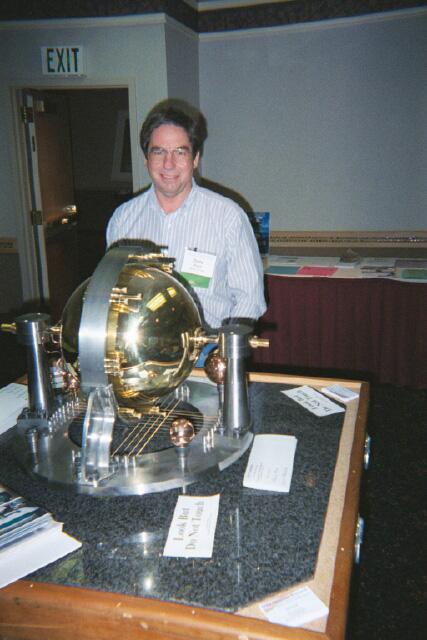
Dale Pond
Author/inventor
Dale Pond has written a number of books, including Universal Laws Never
Before Revealed: Keely’s Secrets, The Physics of Love,
Nikola Tesla’s Earthquake Machine, and The Divine Triplet:
Exploring the Spiritual Nature of Silver, Gold, and Platinum. Pond's
main message for us is that vibration is the principle underlying all
things and phenomena – the link between spirit, mind, and matter
– the magic key for creating new worlds and universes.
Pond demonstrated
one of his beautiful creations, which he said will move without being
touched as a kind of bio-feedback device. Dale's striking Dynasphere
occupied a place of honor in the networking room, where people gathered to
see if they could "get the ball rolling" on its axle. He
explained that he'd built this instrument in the winter of 1995-1996 in an
effort to rediscover John Keely's lost technology. During the time I
attended the conference, I didn't see the device move at all, but Dale
assured me that one woman at the conference had already been cured of some
health problems, simply from having basked in the Love she felt near this
gleaming metallic device.
Dale Pond explained
that dynaspheres, sometimes called musical dynaspheres, globe motors, or
sphere motors, were originally built in the 1880's by John W. Keely. With
his dynaspheres, Keely was reportedly able to power different work loads.
Keely once demonstrated a large unit (four feet in diameter) that was built
to power a locomotive! The dynasphere is a continuous motion machine,
designed to operate within the stream of vibrations passing from the earth
and in conjunction to those vibrations of the celestial domain. Dynaspheres
are completely non-polluting, relying on neither chemical nor other
expensive fuels for their operation. Many people have reported sensing a
powerful healing field around the dynaspheres, and these healing effects
(on the physical, emotional, mental, and spiritual planes) warrant further
study.
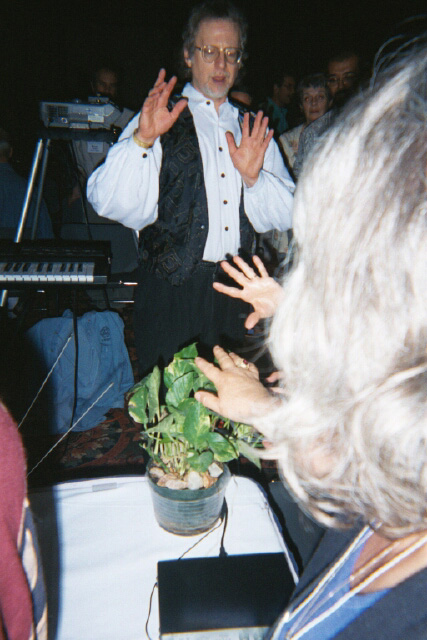
Steven Halpern
Steven Halpern is a
composer and recording artist with over 50 releases. He is also the author
of Sound Health, Sound Matters, and Sound, Stress and Inner Peace. Steven's
music appeals to people from all walks of life, all ages, and religious
backgrounds. His music creates an oasis of serenity without imposing any
demands of its own – so it is played in homes, hospitals, corporate
offices and schools throughout the world to enhance meditation, relaxation,
and to increase productivity and creativity on the job. Halpern's music
touches us completely in a way that we recognize and appreciate at the
highest level of our being.
The evening Steven
Halpern concert was truly amazing, because Steven had a very special guest
performer – a potted plant! A philodendron was hooked up to a MIDI and
synthesizer with two alligator clipped wires, and it proceeded to play a
beautiful, complex piece of very unique music. The philodendron's song
started off sounding a little bit sleepy, then gradually picked up tempo
and proceeded to play a song unlike anything I've ever heard humans play!
It was exquisite, and soothing, and fresh. The notes would rise and sustain
on high notes that sounded something like someone playing a rising scale on
a xylophone … then it would be quiet.
Next, a melody
would begin with lower notes and a chord would hang suspended and sustained
as notes rose slowly … bringing to my mind the vision of water flowing
down gently from a plant's leaves into the soil after a rain. I almost felt
like I could smell the fresh air of the outdoors in this very large
conference room! Halpern explained that some people from Damanhur in Italy
had created the technology which allows any plant to "sing,"
provided the plant is awake and willing to participate.
Steven Halpern
played a very moving piece of music he'd written on the piano, called
"Spectrum Suite," which focuses energy of each of the seven
chakras and brings people to very deep alpha and theta states of
consciousness. He played this piece after having played a couple of other
short songs on the hotel's piano … and then noticed that the piano was
out of tune. Halpern asked for the audience's assistance to intend for the
piano to come into tune – which it did for the exquisite
"Spectrum Suite" song! This song is perfect for anyone who wishes
to help people learn to meditate, or who works with people in a healing
capacity, as the music is extremely energizing and relaxing.
Halpern checked on
the philodendron again, to find out if it wished to perform another song
for us, and it did! This grand finale was a bright and cheery song, which
was very different from the first song … it reminded me of a fond
memory of watching the rising sun! The notes rose at the same speed that
the sun rises on the horizon, and I could imagine the sun coming up with
the first rays of light shining down as the notes "warmed
up"… and also became more frequent. This song was a radiant
expression of unlimited love rising anew! I listened with my eyes shut, and
could visualize as the sun had fully cleared the horizon how the notes
quieted a bit and softened … and the song came to an end.
And so the first
full day of the second annual international conference of science and
consciousness came to a close … as we left the Pyramid ballroom to
discover what interesting dreams we'd have that night.!
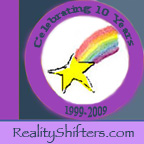 |